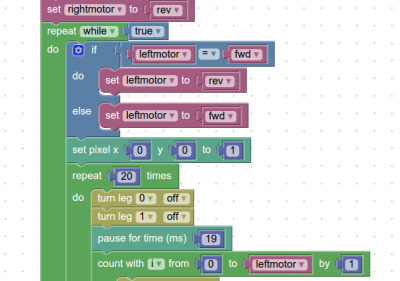What has six legs, 25 LEDs, a Microchip CPU, can be sewn into clothing, and even plugged into a Raspberry Pi? The answer, it turns out, is the CodeBug–a low cost computer board aimed at the educational market. These board were crowdfunded and are now available for general purchase. [Mike Redrobe] took one of the boards, connected a few servos and used the CodeBug’s Scratch-like language to create a small robot.
You can see the robot in the video below. Programs download via USB (the board looks like a USB drive). You can also send commands over USB to operate in tether mode, or you can directly plug the board into a Raspberry Pi.
 One interesting feature is the web site development environment. In addition to offering a repository for sharing and forking projects, it also allows live emulation of a program so you can see what your code will do on a little graphic of a CodeBug right on the web page. Another thing we liked was the ability to view your code in blocks (like the picture to the right) or as traditional code.
One interesting feature is the web site development environment. In addition to offering a repository for sharing and forking projects, it also allows live emulation of a program so you can see what your code will do on a little graphic of a CodeBug right on the web page. Another thing we liked was the ability to view your code in blocks (like the picture to the right) or as traditional code.
Servo robots aren’t anything new (even ones that use a single servo and robotic snakes). However, this is a good alternative to a “hello world” program for these tiny and inexpensive boards.















…. Oh, was that opening question for me?..
Let me think about that….
Mikrochip.. Legs.. Clothing.. RasPi.. Hummm.
oh and LEDs! It’s so obvious now.. That.. Is a bomb. Absolutely no other explanation.
No, it can’t be a bomb unless it has a seven-segment display and is mounted inside a pencil case.
“These boards were crowdfunded and are not available for general purchase.”
Really?
http://uk.farnell.com/codebug/codebug/codebug-programmable-wearable/dp/2479888?categoryId=700000005178
Rats that was a typo. Was supposed to be NOW.
Its available here. The Newark/Farnell site insists its available for $20.15 and gives methods of ordering.
From the headline I was certain this was gonna be about Backyard Brains.
Neat little board! It looks remarkably like the early prototypes of the BBC MicroBit, though. I wonder if there was some inspiration going on there? http://www.bbc.co.uk/programmes/articles/4hVG2Br1W1LKCmw8nSm9WnQ/introducing-the-bbc-micro-bit
I’m thinking so too :)
They were part of the codebug team designing and making the prototype, and split and made their own similar:
http://codebugforum.co.uk/viewtopic.php?f=10&t=33
Ah, neat, thanks for the details. A little odd that there’s no first-hand reports from the team themselves about it!
It’s worth noting, too, that the “Scratch like programming language” is Blockly: https://code.google.com/p/blockly/
A bit more info on the robo (and its smaller brother):
http://letsmakerobots.com/robot/project/codebuggy-a-codebug-robot
I don’t like these lego/puzzle block language visualization/programming tools to me they seem much more confusing than simple line by line code.I appreciate the novelty and attempt to broaden the user base of micro-controllers, but I can;t help but think one would be better off to simply bring back BASIC rather than reinvent the wheel.
It is funny that you mention that. I taught a robotics class to some Jr. High students quite a while ago and the school wanted to use Mindstorms. So I alternated. One session we’d do Mindstorms and the other we would do PBasic with a BoE Bot from Parallax. But what I did like about this is you could look at code or blocks, so you got to pick. But I think you are right on. Except for very simple tasks, the block diagram gets unwieldy in the same way that schematics do and that’s why we use things like Verilog and VHDL.
If you don’t like Blockly you can just use Python on the Codebug (http://www.codebug.org.uk/learn/activity/66/tethering-codebug-with-python/)